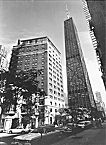| Entries |
| S |
|
Streets, One-Way
|

|
One-way designations spread quickly from commercial districts, marked by an explosion of one-way proposals scattered throughout the city, though this growth seemingly lacked coherence. Traffic combined with a parking crunch in many neighborhoods; streets in older residential areas simply had not been designed to handle automobiles, whether in motion or parked. A one-way designation could double the number of available parking places, and to the residents of dense, apartment -filled blocks, this was an important consideration as ownership of automobiles skyrocketed. Rogers Park saw numerous proposals filed, referred, passed, amended, or rejected. In many cases streets had one-way designations applied and removed several times in the span of five years. For example, some portion of W. North Shore Street was the subject of a one-way proposal in 7 of 10 years during the 1950s. This situation was not stabilized until the late 1960s, when the grid of residential areas such as Rogers Park assumed the form familiar to its modern-day residents.
The number of “one-way” proposals peaked at 224 in 1970–71, thereafter suffering a gradual but steady decline, with only 98 such motions entertained in 1995. Significantly, a growing proportion of the motions were to rescind the one-way designation. Where a solution to traffic problems had been the primary concern of urban planners in the immediate postwar years, by the 1990s new planning doctrines were ascendant that placed a priority on making streets friendly to pedestrians. The paramount example of this shift was south State Street's return to two-way traffic in an effort to revitalize a once-active area. Many downtown streets remain one-way, but the legacy of the “one-way” is the maze of narrow, car-filled streets confronted by Chicago residents each night as they return home.
The Encyclopedia of Chicago © 2004 The Newberry Library. All Rights Reserved. Portions are copyrighted by other institutions and individuals. Additional information on copyright and permissions.